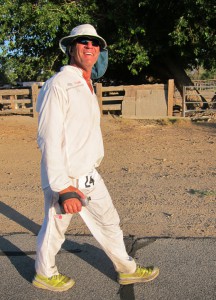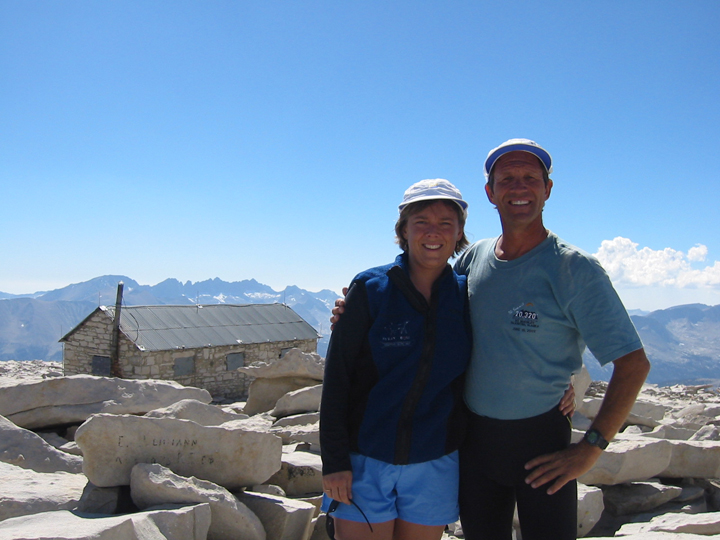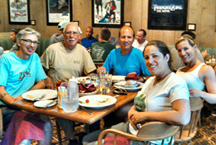Home in the Colorado mountains, the heat and challenges of Death Valley seem almost a dream. Or, is it a nightmare? For some runners, the latter proved to be more accurate at this year’s Badwater Ultramarathon, as 15 of the 96 competitors did not finish (DNF), including several veterans. Many people have asked: Why? Why more DNFs this year? I’ve given this a fair amount of thought and would like to share some ideas.
First, every time I do Badwater I’m reminded that running 135 miles across Death Valley in the heat of summer is never a given. For me it’s a privilege to have competed the Adventure Corps race once again, and I’m grateful to race director Chris Kostman for continuing to put on a world-class event. I’m also grateful to my crew: Perry Gray, Roger Kaufhold, Jill Andersen, and Karen Risch ; and to the desert – and the mountain – for helping me along the way and allowing me to complete the journey.
This year, going up Townes Pass was especially challenging, both physically and mentally. Just after Stovepipe Wells at about mile 42 and at sea level, runners have to travel almost 17 miles to the 4,965-summit of Townes Pass (with Father Crowley’s and Mount Whitney still ahead; Badwater is not a flat race!). At about mile 50 I began to ask myself, “Why the hell am I doing this again?” In the heat of the moment (pun intended) it’s typical to question why anyone would want to compete in such a race, and even harder to convince yourself to keep moving on towards the finish when all you really want to do is quit. For me, when that happens, I have to do a bit of self-imposed brainwashing to quiet my mind and refocus to more positive thoughts in my life. It’s okay to think about quitting. Acknowledge those thoughts, and the realization that the event is very difficult, but then move on. Continuing on must become a singular focus; a focus that can serve us well in life, not just in ultras.
So besides acknowledging the “typical” challenges of Badwater, what was it this year that lead to so many DNFs? Here are some ideas, cautionary words, and preventative steps.
At the 6:00 a.m. start it was near 100 degrees, which is unusual (the desert typically cools off more at night, and doesn’t really start heating up to above 100 degrees until closer to noon), so runners were exposed to high heat for a prolonged period of time. The official high temperature for the day was 120 degrees. The average high in July is 118, so it wasn’t much hotter than normal. Keep in mind when the race was a 6:00 p.m. start, there were several times when the thermometer tipped 120 degrees at the starting line with a general headwind that continued into the night, forcing us to start slower, which brings up the second point.
The new 48-hour time limit, first imposed in 2011 instead of the previous 60-hour time limit, might tend to force a few people into going faster throughout the race; I have also seen people starting out faster each year. Going faster may win the race, but it might not allow you to finish.
I heard some runners and crew theorize that it was more humid than usual, but I don’t think there was an appreciable difference in humidity. Some years it’s actually rained during the race, which made humidity a problem.
By casual observation, it seems more and more people are experimenting with diet. In the heat, it is hard for the body to digest and utilize much more than fluids and small portions of solid food. I eat real food, including some meat an animal-sourced protein (this year chicken, a hamburger, eggs, and bacon), rather than engineered sports foods, and do not subscribe to vegan or vegetarian diets.
For some, salt and other electrolytes may have been a factor, as higher levels of electrolytes are needed to deal with the heat and the exertion. Everyone is different, but in the extremes of Death Valley I was taking one packet (two tablets per packet) of Sustain every hour during the day, and one packet every couple of hours at night, with each packet containing:
- 170 mg of Sodium (as sodium chloride)
- 280 mg of Chloride (as sodium chloride and potassium chloride)
- 15 mg of Calcium (as calcium carbonate)
- 15 mg Potassium (as potassium chloride)

Appropriate desert clothing to enhance cooling: ice hat, loose-fitting white shirt and pants, shoes with plenty of cushioning.
At this, my 19th Badwater 146 (mile) race – more on that name later – I saw more people wearing tight-fitting clothes, compression sleeves and shorts more than ever before. I’ve seen “fads” come and go, and I think tailored clothing is fine, even helpful, for some applications (Zensah is one of my sponsors, and I do wear their products). But, in the desert, loose-fitting clothes allow for ventilation, which aids cooling. Beware of compression sleeves on the legs as they can push edema downward over the course of 135 miles, causing your feet to swell even more, which can create or worsen blisters. Cotton, rather than “tech” material, t- or long-sleeved shirts or compression sleeves, evaporate water more slowly when you get sprayed by your crew, also aiding in cooling. Lightweight, loose, white desert pants will help protect your legs from radiated heat from the pavement. Beware of slick marketing regarding the latest and greatest styles in clothing, as well as footwear, as most are not the best choices, especially for Death Valley.
Every year some runners are forced out because of blisters, and again this year I saw many people let their blisters get to the point where there wasn’t much they could do. If you feel a hot spot, deal with the impending blister right away. Additionally here are a few things that will help to take care of your feet!
- A full shoe size larger can help if foot swelling is a problem; I love shoes with plenty of cushioning to protect my joints, and the thicker sole helps insulate my feet.
- ENGO blister prevention patches applied to the shoe or sock – not your skin – can help keep hot spots from becoming blisters by reducing friction.
- Sportslick anti-bacterial, anti-fungal, friction reducing gel applied on feet, and other body parts, before and during the run is a must have for me.
- Silk weight liner Injinji toe socks under another thin or medium Balega sock. If your toes need more room, just use the Balega socks. Or tape your feet before race start as a prevention against blisters.
Of course, heat is always an issue, and can be deadly. Never forget to keep yourself cool by utilizing ice around the neck and on your head, and keep your core wet by misting. If you have to cool off, ice baths are NOT as effective as misting and fanning a person. Ice all over shuts down the pores and doesn’t allow the body core to cool itself down as rapidly.
Perhaps some runners didn’t hydrate effectively. Take a scale and stay within 3-4 pounds of starting weight.
It’s possible some runners didn’t do effective heat training prior to the race. Check out my post about preparing for the heat. If you find that the heat is unbearable, get into an air-conditioned van (without driving forward, of course – cheating is cheating!).
The new 48-hour cutoff might not sound like a lot of time, but for all except the fastest runners, rest is critical. An hour or two, or even 15-20 minutes here or there, of recovery and even sleep can go a long way to get you to the finish.
A final thought about the Badwater 146:
As I mentioned, this was my 19th Badwater 146 race, as it’s important to me to keep the original intent of the race: 146 miles from the lowest point (Badwater basin at 282 below sea level) to the highest point (the 14,505-foot summit of Mount Whitney) in the lower 48 States. This is a personal challenge for me, and I believe it’s important to continue the tradition and honor those who came before us, those who created the challenge. I encourage runners to get the permits, stay safe, remove any and all race numbers or identification, and experience the mountain as well as the desert. The “Badwater 146” is one of the most diverse and spectacular challenges in the world and well worth the effort.

Reaching the Mount Whitney summit in 2002 with my wife Heather
is one of my most treasured Badwater 146 memories.











Nice summary Marshall. It was my rookie year, and went spectacularly well, likely due to the exhaustive research I did on the event, training methods, my heat training (passive sauna training ala the Grinder), and some well educated decisions. There is a lot of lore about Badwater, both external to the event (“you have to run on the white line or your shoes will melt”) and internal. I can’t count the number of racers who told me one has to wear calf sleeves or your calves will blister from the heat coming off the road. A few hours before I ran I was still undecided if this was BS or not, and was able to question Dean K, who said he didn’t think it was true. So I went without any calf protection, liberally applied sunblock every few hours, and… was totally fine. Another wives’ tale invalidated. (not saying one might like sleeves more than not, but I hate stuff on my legs, want the airflow, and the blistering lore is BS if you actually use sunblock).
Anyway, great to see you out there. What an experience.
-Ken (#94, and a vegan!)